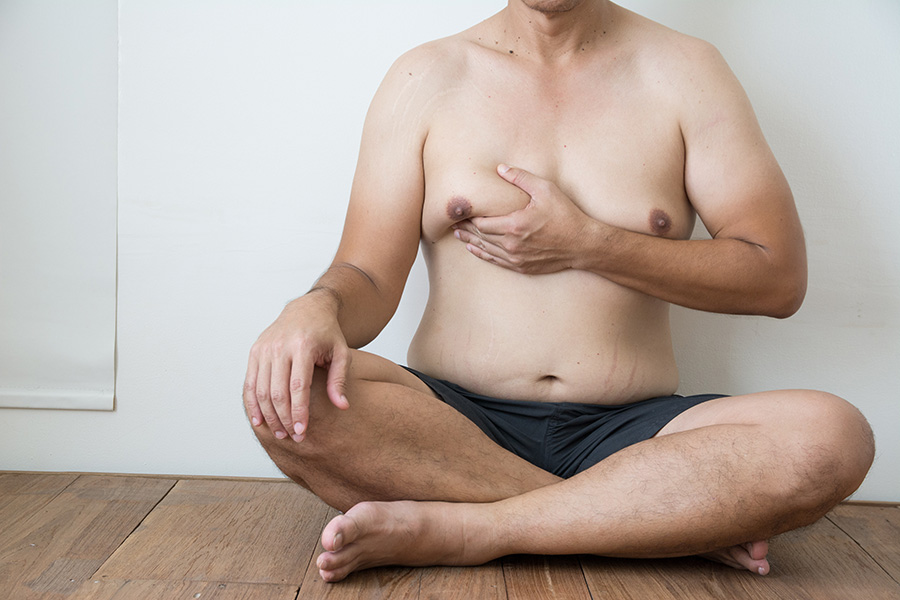What Causes Gynecomastia?
Posted August 06, 2024 in Gynecomastia Surgery

Are you one of the thousands of men who suffer from gynecomastia? The development of excess breast tissue is a condition that can affect men of all ages. Gynecomastia can be an embarrassing problem to deal with, making you feel self-conscious about being seen with your shirt off. It can affect your ability to enjoy days at the pool or even intimacy with your partner. In this blog, we explore the difference between gynecomastia and pseudogynecomastia, as well as the symptoms and causes of gynecomastia.
Gynecomastia Versus Pseudogynecomastia
While gynecomastia isn’t harmful to your health, it can cause feelings of insecurity and embarrassment. However, if you have “man boobs” or “moobs,” it doesn’t necessarily mean that you have gynecomastia. Gynecomastia and pseudogynecomastia are often confused, but there are distinct differences.
Gynecomastia is the development of excess glandular tissue in the breast and is characterized by the following symptoms:
- A small lump that can be felt right under your nipple or off to the side
- Soreness and swelling in the breasts
- Uneven growth of one or both breasts
- Discharge from your nipples, as well as sensitivity, itchiness, or soreness
Pseudogynecomastia is the accumulation of excess fat in the chest due to weight gain. It can usually be reversed with diet and exercise. Gynecomastia may also be reversed with lifestyle changes, but the causes are a bit more complicated. Below, we outline some of the most common causes of gynecomastia.
Hormonal Imbalances and Gynecomastia
The primary cause of gynecomastia is an imbalance of testosterone and estrogen. Both men and women have estrogen and testosterone, just at differing levels. Typically, testosterone is higher in men, while estrogen is higher in women. In cases of gynecomastia, estrogen levels are higher, which not only increases the development of glandular breast tissue but also suppresses the release of testosterone.
While gynecomastia can occur at any time, it is most prevalent during puberty (in 65% of boys) and after age 50 (in nearly 70% of men) due to age-related hormonal changes.
One of the reasons gynecomastia and pseudogynecomastia are often confused is because being overweight can cause a man’s breasts to get bigger. Estrogen hormones are produced in fat, so while an increase in breast size can simply be excess flab, it can also be due to elevated estrogen levels caused by those extra pounds.
Other Causes of Gynecomastia
Discovering the underlying cause of gynecomastia is essential to help eliminate the problem. While the factors listed below may seem overwhelming, keep in mind that gynecomastia is an entirely treatable condition.
Medications
In some cases, the medications you take may increase the risk of developing gynecomastia. Certain medicines used to treat cancer, heart conditions, anxiety, and depression have side effects that can disrupt hormonal balance and result in glandular breast tissue development. In addition, certain herbal supplements and over-the-counter medications can also cause hormonal shifts. Talk to your doctor if you are concerned that a medication or supplement may be contributing to your gynecomastia.
Substance Use
Recreational drugs, such as marijuana, opioids, and amphetamines can cause gynecomastia, decreasing testosterone levels and interfering with natural hormones that block the effects of estrogen in men. Alcohol can also be a culprit, as it can increase estrogen levels and cause liver damage, both of which contribute to gynecomastia.
Anabolic steroid use is also a common cause of gynecomastia. While bodybuilders use steroids to increase their muscle growth, misuse can actually cause a decrease in testosterone, resulting in gynecomastia.
Health Conditions
A few health conditions can influence hormone balance and contribute to gynecomastia:
- Pituitary insufficiency (when the pituitary gland doesn’t produce enough hormones)
- Overactive thyroid
- Liver disease
- Kidney failure
- Tumors of the testes, adrenal, or pituitary glands
Learn More About Gynecomastia Surgery in Coral Gables
While you may be able to treat your gynecomastia with lifestyle changes, sometimes the best solution is gynecomastia surgery, also known as male breast reduction. At Careaga Plastic Surgery, we understand that having enlarged breasts can affect how you feel about your masculinity and your body in general. That’s why we offer several options to our gynecomastia patients—breast tissue removal, ultrasonic liposuction, or both—to ensure that you get optimal results and the smoother, more masculine chest contour that you desire. To schedule a consultation, call our office today at (305) 929-0445 or complete the online contact form.
